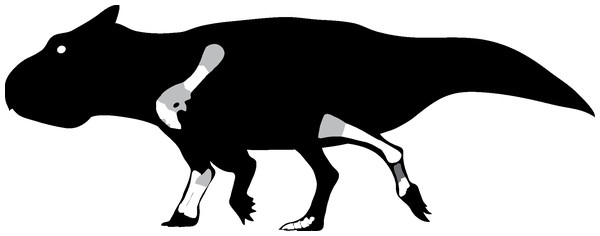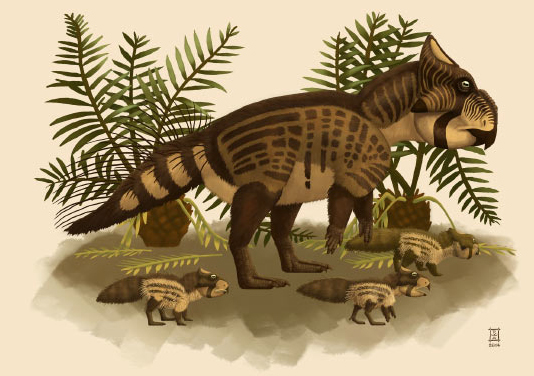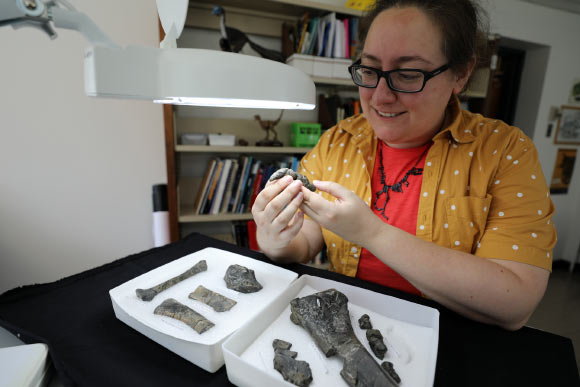The First Unique Dinosaur Species from British Columbia
Ferrisaurus sustutensis – Newest Member of the Leptoceratopsidae
This week has seen the announcement of a new species of horned dinosaur, a member of the Leptoceratopsidae and the first unique dinosaur species to be reported from the Canadian province of British Columbia. The little dinosaur (estimated to be about 1.75 metres long and to have weighed around 150 kilograms), has been named Ferrisaurus sustutensis and it hints of an intriguing prehistoric fauna that roamed the more northerly and western portions of Laramidia around 67 million years ago.
A Life Reconstruction of the Newly Described Leptoceratopsid Ferrisaurus sustutensis
Picture credit: Raven Amos and courtesy of the Royal British Columbia Museum
First an Indeterminate Neornithischian
In 1971, construction workers building the now abandoned British Columbia Rail line close to the confluence of Birdflat Creek and the Sustut River in the Sustut Basin, discovered fragmentary bones in loose rubble. At first the bones were thought to represent an indeterminate neornithischian dinosaur, but in this study undertaken by Dr Victoria Arbour (Royal BC Museum) and Dr David Evans (Royal Ontario Museum/University of Toronto), they have been assigned to the Leptoceratopsidae.
Leptoceratopsids were a family of hornless, parrot-beaked herbivores related to the Ceratopsidae, dinosaurs such as Triceratops and Styracosaurus. These dinosaurs were restricted to the Late Cretaceous of the Northern Hemisphere, but there is some disputed fossil evidence to suggest a presence in Australia and in Europe too.
Dr Arbour Examining the Fossilised Remains of Ferrisaurus sustutensis
Picture credit: Brandy Yanchyk and courtesy of the Royal British Columbia Museum
Ferrisaurus sustutensis
Fossil remains include elements from the shoulder girdle, a complete left radius, a partial ulna along with hind limb bones, ankle bones and articulated toes from the right foot. An as yet, unprepared block may also contain metatarsals from the left foot. The researchers used the ulna (bone from the forearm) and compared it with other leptoceratopsids such as Leptoceratops (L. gracilis), Cerasinops (C. hodgskissi) and Montanaceratops (M. cerorhynchus).
They also examined the proportions of the toes and concluded, based on this assessment, that the fossilised remains represented a new genus, one that is phylogenetically firmly nested in the Leptoceratopsidae and probably quite closely related to Gryphoceratops morrisoni, which is known from the Dinosaur Provincial Park of southern Alberta.
Ferrisaurus sustutensis – What’s in a Name?
Ferrisaurus sustutensis (pronounced Fair-uh-sore-us suss-tut-en-sis), is the first unique dinosaur species reported from British Columbia and represents a western range extension for Laramidian leptoceratopsids. The name translates as “the iron lizard from the Sustut River”, a reference to the location of the fossil discovery. When the fossil material was being prepared and studied the specimen was affectionately known as “Buster”.
Scientists are confident that more vertebrate fossil material will be found in the Upper Cretaceous rocks of the Sustut Basin, but there are problems with accessing and exploring this area. As much of British Columbia is mountainous and forested, finding exposures of sedimentary rock to explore is challenging. In 2017, Dr Arbour led a field team to the site and found fossilised plants and a fragment of a Cretaceous turtle (Basilemys).
Leptoceratopsid fossil material is quite rare and when these types of dinosaurs are found, they usually only represent a very small part of the dinosaur biota. It is more usual for Upper Cretaceous, dinosaur fossil bearing strata to be dominated by duck-billed dinosaurs, horned dinosaurs or even tyrannosaurids.
Scientists have documented a preservational bias against small-bodied dinosaurs such as Ferrisaurus. The first dinosaur to be described from the Sustut Basin might represent a fauna that was relatively unique to that part of Laramidia, or to find a leptoceratopsid dinosaur first, could simply be down to serendipity.
A Diagram Showing the Known Preserved Remains of Ferrisaurus sustutensis

Picture credit: PeerJ/Royal British Columbia Museum
The scientific paper: “A new leptoceratopsid dinosaur from Maastrichtian-aged deposits of the Sustut Basin, northern British Columbia, Canada” by Victoria M. Arbour and David C. Evans published in the journal PeerJ.
The Everything Dinosaur website: Everything Dinosaur’s Website.



